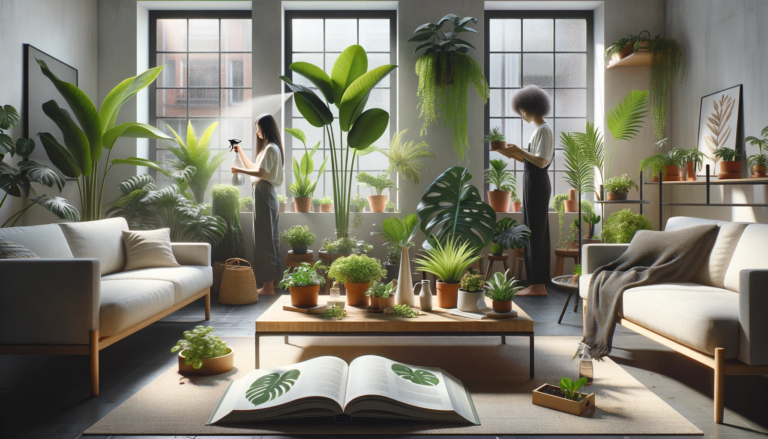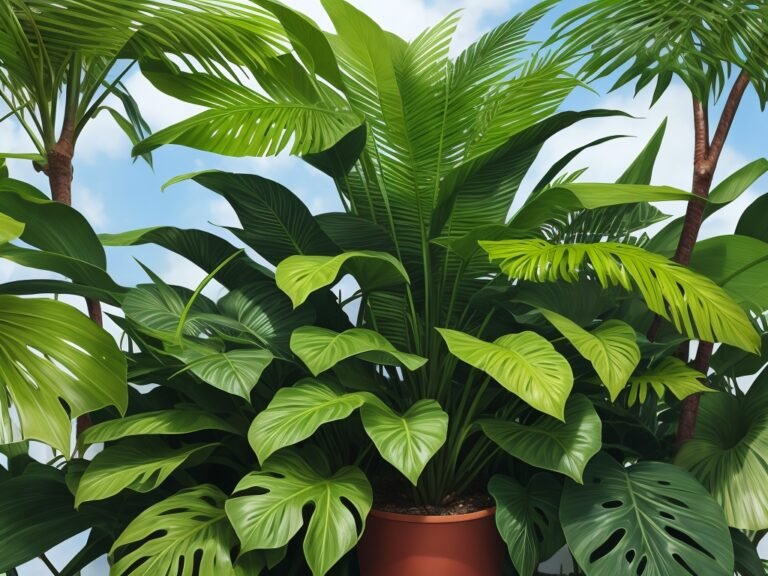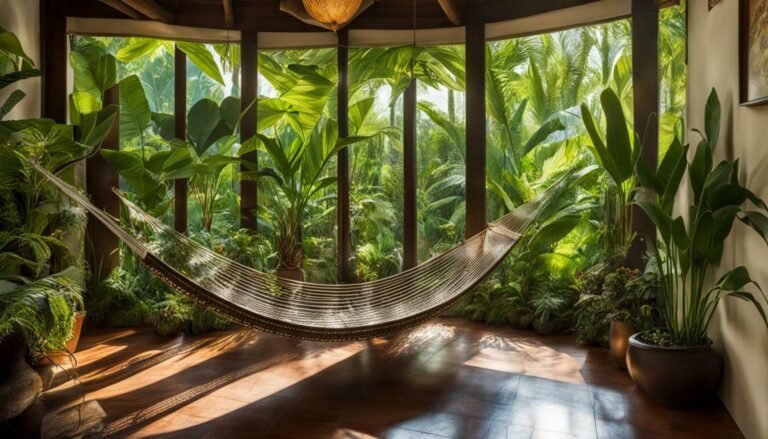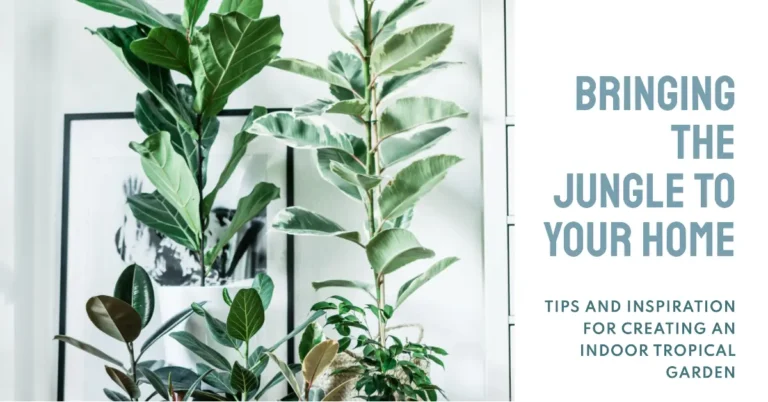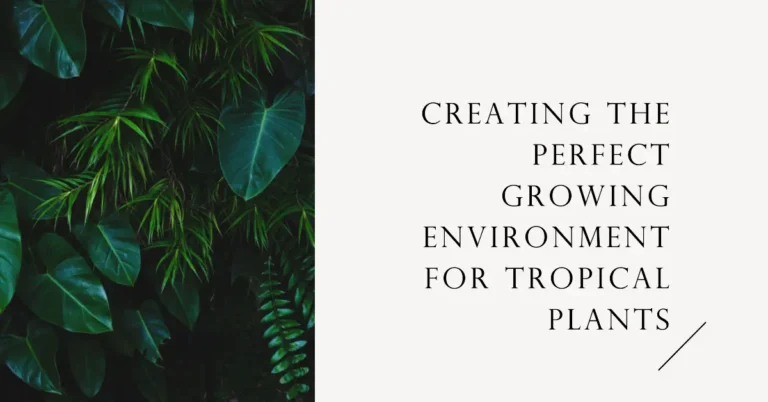Decorating With Tropical Houseplants: 12 Stylish Ideas For Every Room
Key Takeaways:
- Tropical houseplants add a vibrant and exotic touch to any room.
- Hanging plants can create a beautiful and space-saving display.
- Mixing different types of tropical houseplants can create a lush and dynamic look.
- Don’t be afraid to experiment with different pots and containers to enhance the overall aesthetic.
Are you looking to bring a touch of the tropics into your home? Well, look no further! In this blog article, I’ll be sharing 12 stylish and creative ideas for decorating with tropical houseplants in every room of your house.
From choosing the right plants for specific spaces to incorporating them into different interior design styles, I’ll cover it all.
Plus, I’ll provide tips on caring for your tropical houseplants, addressing common concerns, and answering frequently asked questions. Get ready to transform your home into a lush and vibrant oasis with the help of these tropical beauties!
| Idea | Plant | Lighting | Location | Watering |
| 1. Living Room Focal Point | Monstera Deliciosa | Bright, indirect light | Corner or near windows | Keep soil slightly moist |
| 2. Dining Room Table Centerpiece | Philodendron Birkin | Indirect light | Center of the table or nearby | Allow soil to dry slightly between waterings |
| 3. Bedroom Serenity | Snake Plant | Low to bright light | Near the bed or on a nightstand | Water sparingly, allow soil to dry completely |
| 4. Office Productivity Booster | Spider Plant | Low to bright light | On a desk or near a window | Keep soil evenly moist |
| 5. Bathroom Greenery | Pothos | Low to medium light | Hanging from a hook or on a shelf | Allow soil to dry slightly between waterings |
| 6. Kitchen Statement Piece | Bird of Paradise | Bright, indirect light | In a large, well-lit corner | Keep soil slightly moist |
| 7. Entryway Welcome | Fiddle Leaf Fig | Bright, indirect light | By the main entrance | Water when the top inch of soil is dry |
| 8. Patio Oasis | Hibiscus | Full sun to partial shade | On the patio or balcony | Water deeply when the top inch of soil is dry |
| 9. Home Office Air Purifier | Peace Lily | Low to medium light | On a desk or shelf | Keep soil evenly moist |
| 10. Children’s Playroom Fun | Rubber Tree | Medium to bright light | Corner or against a wall | Allow soil to dry slightly between waterings |
| 11. Small Apartment Size | Succulents (e.g., Echeveria) | Bright, indirect light | On windowsills or shelves | Water sparingly, allow soil to dry completely |
| 12. Hanging Garden | String of Pearls | Indirect light | Hanging from hooks or in a macrame planter | Allow soil to dry between waterings |
Choosing the Right Tropical Houseplants for Each Room
Decorate each room with the appropriate tropical houseplant to suit its unique characteristics and needs.
Best tropical houseplants for living rooms
Here are some of the best tropical houseplants for living rooms:
- Snake Plant (Sansevieria: Known for its air-purifying properties and low maintenance needs, it can thrive in a variety of light conditions.
- Fiddle-Leaf Fig (Ficus lyrata: With its large, glossy leaves, this plant adds a touch of drama and elegance to any living room.
- Swiss Cheese Plant (Monstera deliciosa: Its unique, fenestrated leaves make it a popular choice for creating a tropical atmosphere.
- ZZ Plant (Zamioculcas zamiifolia: Perfect for low-light conditions, this plant has shiny, dark green leaves that bring a tropical vibe to any living room.
- Bird of Paradise (Strelitzia reginae: Known for its vibrant orange and blue flowers, this plant can be a stunning focal point in a living room.
Remember to consider your specific lighting conditions and care preferences when choosing a tropical houseplant for your living room.
Ideal tropical houseplants for bedrooms
Ideal tropical houseplants for bedrooms include:
- Peace Lily: Known for its air-purifying properties and beautiful blooms.
- Snake Plant: Thrives in low light conditions and helps improve indoor air quality.
- Areca Palm: Adds a touch of tropical vibes with its elegant fronds.
- Philodendron: Easy to care for and adds a lush green look to any bedroom.
- Pothos: Cascading vines that can be hung or placed on a shelf for added aesthetic appeal.
Tropical houseplants suitable for bathrooms and kitchens
Tropical houseplants suitable for bathrooms and kitchens include:
- Spider Plant: Thrives in low light and humid conditions.
- Aloe Vera: Requires bright light and minimal watering.
- Peace Lily: Filters air and tolerates low light.
- English Ivy: Great for hanging in bathrooms.
- ZZ Plant: Tolerates low light and infrequent watering.
Tropical houseplants for home offices and study areas
Tropical houseplants can be great additions to home offices and study areas.
Here are a few options to consider:
- Snake Plant: Known for its air-purifying qualities and low maintenance requirements.
- ZZ Plant: Thrives in low-light conditions and adds a touch of greenery without much effort.
- Pothos: Easy to care for and can help improve indoor air quality.
- Peace Lily: Known for its ability to filter harmful toxins from the air.
- Spider Plant: Requires minimal care and can tolerate a range of lighting conditions.
Having tropical houseplants in your workspace can create a calming and productive environment.
Just make sure to choose plants that suit the lighting conditions and your level of commitment to care.
Creative Ways to Decorate with Tropical Houseplants
Looking for creative ways to decorate with tropical houseplants? Here are some stylish ideas for you!
Hanging tropical houseplants
To decorate with hanging tropical houseplants, choose trailing plants like pothos, philodendron, or string of pearls. Hang them in hanging baskets or macramé planters from the ceiling or on walls.
Make sure to place them near windows for adequate light and water them regularly to keep them healthy.

Creating a tropical centerpiece
Creating a tropical centerpiece is a great way to add a touch of exotic beauty to your space. Start by selecting a large, vibrant tropical plant as the focal point.
Surround it with smaller, complementary plants for added texture and depth.
Add decorative elements like rocks, seashells, or colorful pebbles to enhance the tropical theme. Place the centerpiece on a stylish tray or in a decorative pot to complete the look.
Voila! You have a stunning tropical centerpiece that will infuse your space with a fresh and tropical vibe.
Using tropical houseplants as room dividers
Using tropical houseplants as room dividers can add greenery and separation to your space. Choose tall, bushy plants like palms, bamboo, or monstera deliciosa.
Place them strategically to create a natural barrier between different areas of your room.
It’s an easy and stylish way to define spaces while bringing a touch of nature indoors.
Incorporating tropical houseplants into shelving and bookcases
To incorporate tropical houseplants into your shelving and bookcases, here are a few ideas:
- Utilize hanging planters: Hang small tropical plants from the shelves using hooks or macrame hangers for a cascading effect.
- Create plant-filled vignettes: Arrange books and decorative objects on the shelves, leaving spaces for small potted tropical plants to add pops of greenery.
- Use plant stands: Place taller tropical plants on stylish plant stands on the shelves, allowing them to be showcased amidst your books and decor.
- Group plants of various sizes: Arrange different-sized tropical houseplants together on a shelf to create a visually appealing display.
- Combine with other decorative elements: Pair your tropical houseplants with vases, candles, or small sculptures to add texture and visual interest to your shelving.
Remember to consider the light and humidity needs of your tropical houseplants when placing them on shelves.
Tropical Houseplants for Small Spaces and Apartments
Limited on space?
No worries – these compact tropical houseplants are perfect for small rooms and apartments.
Compact tropical houseplants for small rooms
Compact tropical houseplants are perfect for small rooms as they won’t take up too much space. Some great options include the snake plant, pothos, peace lily, and ZZ plant.
These plants are small but still add a touch of greenery to your space.
Plus, they are relatively low-maintenance and can thrive in various light conditions. Don’t forget to consider the size and growth habit of the plant before making your final choice.

Vertical gardening with tropical houseplants
Vertical gardening with tropical houseplants is a creative way to make the most of limited space. You can use wall-mounted planters, hanging baskets, or trellises to create a lush and green vertical display.
Some suitable tropical houseplants for vertical gardening include pothos, philodendrons, ferns, and spider plants.
These plants thrive in indoor environments and can add a touch of natural beauty to any room. Just make sure to provide them with proper lighting and regular watering.

Decorating with hanging tropical houseplants in apartments
Decorating with hanging tropical houseplants in apartments is a great way to add a touch of greenery and visual interest to your space.
To get started, choose houseplants that thrive in low-light conditions and are suitable for hanging.
Some popular options include pothos, spider plants, and ivy.
Hang them in decorative planters or macrame hangers and place them near windows or in well-lit areas.
Don’t forget to regularly water and care for your plants to keep them healthy and thriving.
Styling Tropical Houseplants with Different Interior Design Styles
Create a stylish look by pairing tropical houseplants with different interior design styles.
Modern interior design with tropical houseplants
In modern interior design, tropical houseplants can add a fresh and vibrant touch to your space. They provide a natural element that complements sleek and clean lines.
Some popular choices for modern interiors include the snake plant, fiddle leaf fig, and bird of paradise.
These plants not only bring visual appeal but also improve air quality and create a calming atmosphere. Place them in stylish planters and use them as focal points or accents in your modern decor.
Bohemian and eclectic styles with tropical houseplants
Bohemian and eclectic interior design styles are perfect for showcasing tropical houseplants. These styles embrace a mix of colors, patterns, and textures, creating a vibrant and layered atmosphere.
Consider using macrame hangers to display your tropical plants, or place them in mismatched pots for an eclectic look.
Bohemian and eclectic styles also encourage creative placement, so incorporate plants on shelves, tables, or as an accent in a gallery wall. The lush and exotic foliage of tropical houseplants will bring a lively and free-spirited vibe to these design styles.
Minimalist interior design featuring tropical houseplants
In a minimalist interior design, tropical houseplants can add a touch of freshness and vibrancy. Choose plants with sleek and simple foliage, such as snake plants or ZZ plants.
Keep the plant selection minimal, focusing on a few high-quality specimens.
Opt for clean and streamlined plant containers that blend seamlessly with the overall decor. Place the plants strategically to create a sense of balance and harmony in the space.
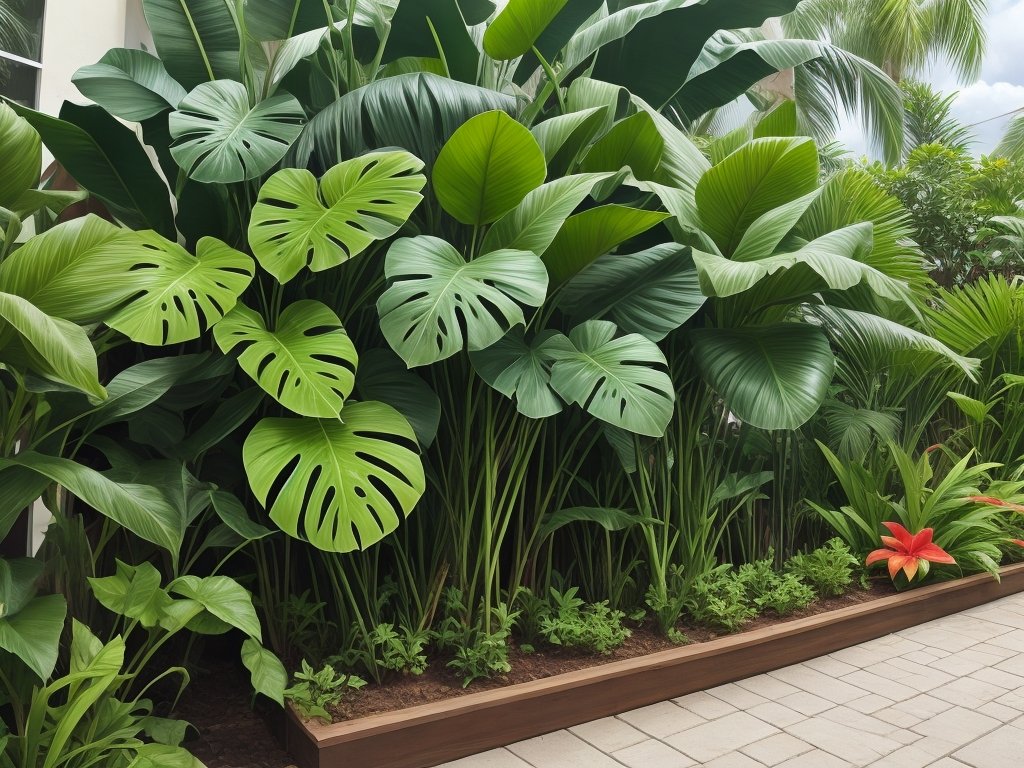
Coastal and tropical-themed interiors with tropical houseplants
Coastal and tropical-themed interiors can be brought to life with the addition of tropical houseplants. Choose plants that thrive in humid environments, such as palms, ferns, and orchids.
Create a beachy vibe with plants like bird of paradise or banana trees.
Use colorful pots and natural materials to enhance the tropical feel.
Caring for Tropical Houseplants
Taking care of tropical houseplants involves providing proper lighting, watering, and humidity, as well as addressing common pests and diseases.
General care tips for tropical houseplants
To keep your tropical houseplants healthy, here are some general care tips:
- Provide the right amount of light: Most tropical plants thrive in bright indirect light.
- Maintain proper watering: Water when the top inch of soil feels dry, and make sure to drain any excess water from the pot.
- Maintain humidity levels: Tropical plants love humidity, so misting their leaves or using a humidifier can help create the right environment.
- Fertilize regularly: Use a balanced liquid fertilizer once a month during the growing season to provide essential nutrients.
- Keep an eye out for pests: Check your plants regularly for signs of pests like aphids or spider mites, and treat them promptly if found.
Remember, each plant has specific care requirements, so it’s always good to do some research on the specific plants you have.
Lighting requirements for tropical houseplants
Tropical houseplants thrive in bright, indirect light.
Place them near windows with filtered sunlight, or use sheer curtains to diffuse the light.
Some tropical plants can tolerate low light, but they may not grow as well.
Avoid direct sunlight, as it can scorch the leaves.
Regularly rotate your plants to ensure even light distribution.
Watering and humidity needs of tropical houseplants
To keep your tropical houseplants happy and healthy, make sure you water them consistently.
Tropical plants usually prefer moist soil, so water them when the top inch of soil feels dry.
It’s important not to overwater, as this can lead to root rot.
Additionally, tropical plants thrive in high humidity environments.
You can increase humidity by misting the leaves or placing a tray of water nearby.
Regularly monitoring the moisture levels and adjusting accordingly will help your tropical houseplants flourish.
Dealing with common pests and diseases in tropical houseplants
To deal with common pests and diseases in tropical houseplants, it’s important to be proactive.
Regularly inspect your plants for any signs of pests like aphids, mealybugs, or spider mites.
If you spot any, immediately isolate the affected plant and treat it with an appropriate insecticidal soap or natural remedies like neem oil.
For diseases like leaf spot or powdery mildew, ensure good air circulation and avoid overwatering.
Remove any infected leaves and treat the plant with a fungicide if necessary.
Prevention is key, so be mindful of proper watering and avoid over-fertilizing, as this can weaken your plants and make them more susceptible to pests and diseases.
Regularly clean your plants and their surrounding areas to prevent buildup of dust and debris, which can attract pests.
Remember, different plants may have specific pests or diseases they are prone to, so research your specific plant’s needs and take appropriate measures.
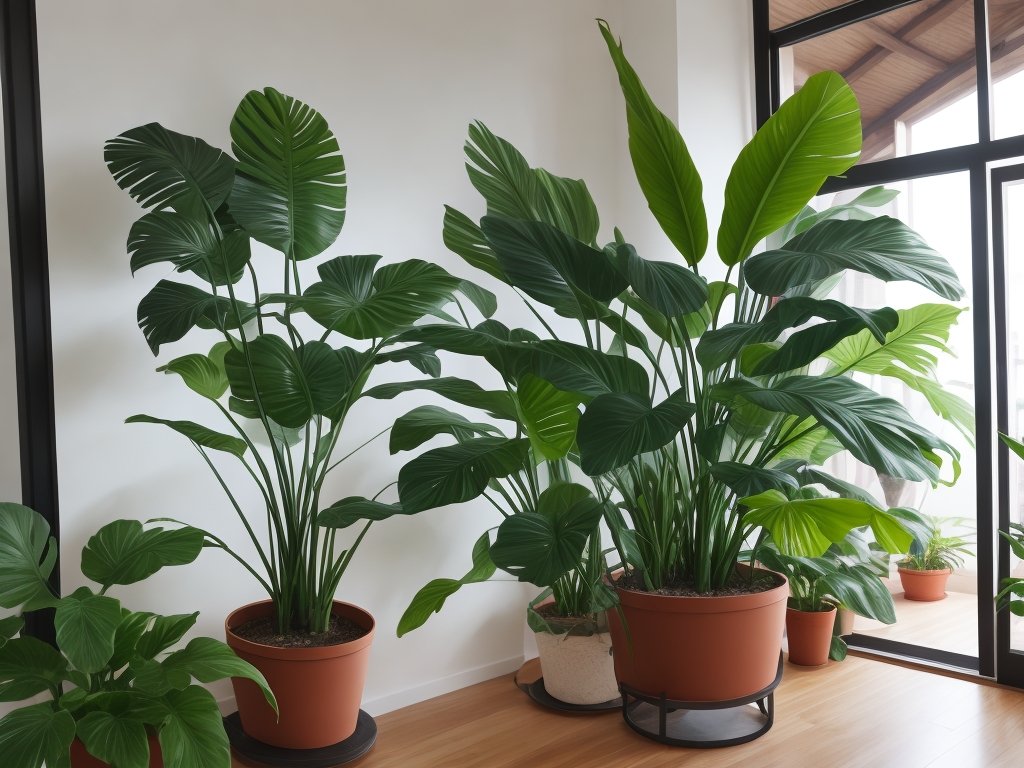
Frequently Asked Questions about Decorating with Tropical Houseplants
Can I decorate with tropical houseplants if I have pets?
Yes, you can decorate with tropical houseplants even if you have pets. However, it’s important to choose plants that are safe for your furry friends.
Some pet-friendly options include spider plants, Boston ferns, and ponytail palms.
It’s also essential to ensure that your pets cannot access or ingest any toxic parts of the plants.
What are some low-maintenance tropical houseplants for beginners?
Some low-maintenance tropical houseplants for beginners include the pothos, snake plant, ZZ plant, and peace lily. These plants are known for their durability, adaptability, and ability to thrive in various light conditions.
They require minimal watering and can tolerate occasional neglect.
Perfect for those just starting out with houseplants!
How do I prevent tropical houseplants from outgrowing their space?
To prevent tropical houseplants from outgrowing their space, you can do a few things:
- Choose the right-sized plant for your space initially.
- Regularly prune and trim your plants to control their growth.
- Provide proper care and maintenance, including appropriate watering and fertilizing.
- Repot your plant into a larger pot when necessary, giving the roots more room to grow.
- Consider rotating your plants to ensure all sides get equal light exposure and prevent uneven growth.
Can I decorate with tropical houseplants in low-light areas?
Yes, you can decorate with tropical houseplants in low-light areas. Some tropical houseplants, like snake plants and ZZ plants, can tolerate low-light conditions and still thrive.
These plants have adapted to survive in the understory of tropical forests where light is limited.
Just make sure to place them near a window or provide artificial light to keep them healthy.
Final Verdict
Decorating with tropical houseplants is a versatile and stylish way to enhance the beauty and ambiance of every room in your home. By choosing the right tropical houseplants for each space, incorporating creative design ideas, and considering the specific needs of these plants, you can create a unique and inviting atmosphere.
Whether you have a small apartment or a spacious house, or whether your interior design style is modern, bohemian, minimalist, or coastal, tropical houseplants can seamlessly complement your decor.
By following the tips and guidelines provided, you can easily care for and maintain these plants for long-lasting beauty. So go ahead and bring the tropics into your living space!


